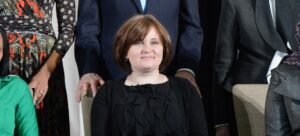The town time forgot
Planned as a model urban community, Cullacabardee was once filled with Indigenous families and playgrounds, but today it’s virtually abandoned, with its few remaining residents facing an uncertain future.
Cul-de-sacs occupied by single homes and paved driveways leading to empty lots are all that remain of Western Australia’s forgotten Aboriginal “housing experiment”.
Nestled in the bushlands of Perth’s northern suburbs on Whadjuk Noongar lands, Cullacabardee was established in the 1980s and once housed more than 100 people.
Now it’s the last housing community of its kind in the metropolitan area.
Community in limbo
Sitting at her dimly lit kitchen table, Cullacabardee’s Julie Lewis is among about a dozen residents living in one of the last five homes at a settlement which once had 31 dwellings.
“We are still here,” she said.
The community’s future is uncertain, partly because of asbestos contamination, and the state government is yet to provide any clarity on what its plans are for Cullacabardee.
“We’re in big limbo,” Ms Lewis said.
Guitar-playing pastor You-Sin Houe is another to bear witness to the community’s decline.
For the last 20 years, Mr Houe has delivered his Sunday morning sermon to an increasing number of empty chairs in Cullacabardee’s community centre.
“A lot of children and families enjoyed this community,” Mr Houe said.
“Now only a few people are here, and all the people are gone.
“I’m very sad because this community is their identity, they really love this land.”
Troubled past, unknown future
Cullacabardee was built by the WA and Commonwealth governments as a “community welfare proposal” and “housing experiment”, according to media reports of the day.
Aboriginal families were resettled from makeshift camps on Perth’s outskirts to conventional, double-bricked homes in Cullacabardee.
Community unrest and violence marred the settlement in the decades that followed.
Public housing was gradually knocked down and never rebuilt.
Ms Lewis said Cullacabardee became a liability and had been left to slowly die.
“That’s due to the government wanting no people out here,” she said.
The Department of Planning, Lands and Heritage (DPLH) did not respond to direct questions about whether funding and provision of housing at Cullacabardee would be restored.
“DPLH has been working closely with the local community to ensure the current residents of Cullacabardee have better social and economic outcomes,” a spokesperson said.
WA Aboriginal Affairs Minister Tony Buti declined the ABC’s request for an interview.
The community’s fate is similar to the now-demolished Swan Valley Nyungah community in the nearby suburb of Lockridge.
The Swan Valley camp was shut down by an act of parliament in 2003 following an inquiry into sexual abuse in Aboriginal communities.
University of Sydney emeritus professor Peter Phibbs has studied affordable and Aboriginal housing over the last 30 years.
He said the “self-determination” approach to Aboriginal housing prevailed through the 1980s and 1990s, in which Aboriginal housing organisations were the main vehicle for housing delivery.
That was dismantled during the Howard government’s interventionist era from 2007.
Dr Phibbs’ research found the number of Aboriginal housing organisations almost halved from 616 to 330 between 2001 and 2012.
“I think for many Aboriginal communities, and housing organisations, they found that change quite bewildering, and really a setback in terms of where they were moving,” he said.
A slow demise
Bricks and twisted metal strewn in the sand of nearby vacant blocks remind Ms Lewis of the old days, when each street had a communal barbecue and playground.
The Cullacabardee community has since fallen into obscurity.
“It’s like we are forgotten,” Ms Lewis said.
The few homes left are owned and managed by the Cullacabardee Aboriginal Corporation.
State government funding has all but ceased.
The Cullacabardee land reserve is held by WA’s Aboriginal Lands Trust, though the state government said it supported divesting this land to Aboriginal ownership.
Ms Lewis wonders where that leaves the community.
“For most of us, we think one day they’ll come out and say ‘youse have got to go’. Where do we go?” she asked.
Asbestos and ‘the pit’
A dusty dirt road leads to what locals call “the pit” — an illegal landfill littered with bush-basher cars and detritus.
Ms Lewis said authorities fenced off the area about eight years ago, erecting asbestos warning signs.
She claims authorities have left residents in the dark about the extent of the contamination and plans to deal with it.
“Are we exposed to it?” she asked.
“Are our kids exposed to it?”
“We don’t know.”
Cliff Weeks, the former director general of the now-amalgamated Department of Aboriginal Affairs addressed the issue at an estimates committee in WA’s parliament in May 2016.
“The asbestos is located in a tip that was never approved,” he said.
“Without going back too far, when I was working in the Department of Housing, Cullacabardee residents were accepting cash payments for trucks to drop off rubbish.”
Mr Weeks said asbestos experts gave advice of “limited” risk around airborne exposure, and the department would go through the process of working out how to “get rid of the asbestos”.
But eight years later, the problem remains.
A spokesperson from WA’s Department of Planning, Lands and Heritage said the department was “developing a broader strategy” to address contamination and support “divestment”.
“[The department] has engaged a qualified environmental consultant to complete further investigation works to inform future remediation requirements,” they said.
“Environmental investigations have been undertaken to assess the contamination in the area.”
Ms Lewis said the findings of those investigations are yet to be provided to the Cullacabardee Aboriginal Corporation.
No native title
Cullacabardee is yet to be included in a landmark $1.3 billion native title settlement covering WA’s South West.
Inclusion in the settlement, struck between traditional owners and the WA government in 2021, could provide new avenues of funding for development and housing at the community.
A spokesperson from the Whadjuk Aboriginal Corporation, whose territory encompasses Cullacabardee, said the state government had “recently notified” the corporation the Cullacabardee land parcel was under an “initial review” for inclusion in the settlement.
“The Whadjuk Aboriginal Corporation has not made any decision regarding the acceptance or rejection of this property,” the spokesperson said.
‘We’re still out here’
Whether government or Aboriginal-owned, Ms Lewis said residents just wanted a say in the future of their community.
“What would be good about is that when they make a decision, be mindful, we’re still out here,” she said.
Looking out her kitchen window at surrounding banksia trees and bushlands, Ms Lewis said life in limbo had its positives.
“Then again, it’s nice to be forgotten too, because we can still live out here.”
Want more local WA news?
Select “Western Australia Top Stories” from either the ABC News home pageor the settings menu in the app.
More local WA reads
Cullacabardee
Forgotten community
Cullacabardee is in Perth’s north east.
Nestled among the she-oak and banksia forest in Perth’s north east lies a once bustling Aboriginal community at risk of fading into obscurity.
Big Ben
Giant peak
Big Ben rises 2,745 metres above sea level.
Australia’s highest peak is not Mount Kosciuszko but a far-flung icy volcano where intrepid mountaineers put their lives on the line to summit.
Perth mother shines
Incredible bravery
Ebony Jones showed incredible bravery.
When Ebony Jones received a phone call from the daughter of a friend saying her father was bashing her mum, she got straight in her car and went to help protect them.
Customers wary
Bank emails
An image of an email sent to ANZ customers.
Customers are confused by banks asking for their personal details over the phone or in emails as consumer protection advice warns against answering.
Odyssey format by ABC News Story Lab



